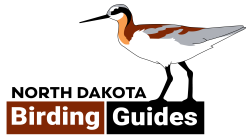Locations
Yellow Rail © Seth Owens
Birding Locations
We guide throughout the state and can meet you anywhere. Below are North Dakota’s main birding regions along with a selection of their characteristic birds. Explore these regions and birds for inspiration on where to go and what to expect!
Fargo - Grand Forks - Devils Lake - Valley City
Eastern North Dakota
The Red River separating North Dakota and Minnesota is a north flowing river that reaches all the way to Winnipeg, Manitoba Canada. It was laid down by the historic Paleogeographic Lake Agassiz. It is home to upland deciduous forests that extends into Canada as well as tallgrass prairie such as the Sheyenne Grasslands.
This is the best region for species such as Greater Prairie Chicken and Yellow Rail. Wider-ranging species in eastern North Dakota include Western Grebe and Eared Grebes, American Bittern and Least Bittern, Sora and Virginia Rails, Franklin’s Gull, Swamp Sparrow and Marsh Wren and Sedge Wrens. In city limits there is a chance for species such as Gray Partridge. In the northeast deciduous forest of the Pembina Gorge and Turtle Mountains there is also a great chance for Scarlet Tanager, Orange-crowned Warbler, and Ruffed Grouse, as well as Black-billed Cuckoo. In the wintertime eastern North Dakota boasts a wide-range of wintering finches such as Red Crossbill, White-winged Crossbill, Common Redpoll and the occasional Pine Grosbeak and Evening Grosbeak. Along the Red River in the winter can hold Northern Saw-Whet Owl, Long-eared Owl and Snowy Owl.
Greater Prairie-Chicken © Jim Merritt, Virginia Rail © Matt Misewicz, Least Bittern © Jack Parlapiano, American Bittern © Shailesh Pinto, Swamp Sparrow © Shailesh Pinto, Marsh Wren © Shailesh Pinto, Sedge Wren © Shailesh Pinto, Scarlet Tanager © Shailesh Pinto, Orange-crowned Warbler © Jim Merritt, White-winged Crossbill © Shailesh Pinto, Common Redpoll © Shailesh Pinto, Pine Grosbeak © David Tønnessen, Evening Grosbeak © David Tønnessen, Northern Saw-whet Owl © Levi Plummer, Red Crossbill © Brian Genge, Long-eared Owl © Nick Ramsey, Ruffed Grouse © Seth Owens, Gray Partridge © Liam Hutcheson, Franklin’s Gull © Matt Misewicz, Eared Grebe © Matt Misewicz, Western Grebe © Michael Stremciuc.
Jamestown - Bismarck - Minot
Central North Dakota
Central North Dakota known as the Missouri Coteau, is a mixed-grass prairie with wetlands known as the Prairie and Pothole region, this consists of Alkaline lakes, supporting the highest number of breeding ducks in North America. The rolling hills of the western most extent of glaciation in North Dakota is home to many grassland specialty birds.
Central North Dakota is the best region to find Baird’s Sparrow, LeContes Sparrow, Nelson’s Sparrow and Sprauge’s Pipit along with Chestnut-collared Longspur. Perched up high on fence posts yield Upland Sandpipers, along the Missouri River nesting Piping Plovers and Least Terns. The scrub brush in the south central part of the state boasts Bell’s Vireo and Blue Grosbeak. The shortgrass prairie of central North Dakota consists of singing Grasshopper Sparrows and Vesper Sparrows, you may also find Dickcissel and Bobolinks displaying in the breeding season. The wintertime is best for odd-ball Gull species at the Garrison Dam such as Iceland Gull, Lesser-Black-backed Gull, Glaucous Gull, Black-legged Kittiwake, along the tailrace of the dam you’ll find many overwintering waterfowl species such as Long-tailed Duck, Common Mergansers and Common Goldeneye with an occasional Barrow’s Goldeneye.
Baird’s Sparrow © Matt Misewicz, Sprague’s Pipit © Matt Misewicz, Chestnut-collared Longspur © Matt Misewicz, Piping Plover © Jack Parlapiano, Least Tern © Liam Wolff, Blue Grosbeak © Matt Misewicz, Grasshopper Sparrow © Matt Misewicz, Vesper Sparrow © Shailesh Pinto, Bobolink © Matt Misewicz, Iceland Gull © Liam Wolff, Black-legged Kittiwake © Shailesh Pinto, Common Merganser © Matt Misewicz, Common Goldeneye © Matt Misewicz, Barrow’s Goldeneye © Jack Parlapiano.
Dickinson - Williston - Watford City - Medora
Western North Dakota
Known as the Badlands, rich with lignite coal beds, clay-scoria slopes and buttes, steep canyons dotted with Rocky Mountain Juniper and Ponderosa Pine and shortgrass prairie, it is a unique landscape home to many specialty birds. The Badlands is also home to the famous Theodore Roosevelt National Park, named after President Theodore Roosevelt.
The Badlands of North Dakota consist of many western specialty birds such as Bullock’s Oriole, Greater Sage Grouse, Long-billed Curlew, Blue-Gray Gnatcatcher and Violet-green Swallow. Brewer’s Sparrow hidden within the sagebrush along the red scoria roads of the southwest. More wide-spread species of the west include Yellow-rumped Warbler (Audubon’s), Red Crossbill, Mountain Bluebird, Yellow-breasted Chat, Prairie Falcon, Black-headed Grosbeak and Western Wood-Pewee singing in the tops of cottonwoods and soaring Golden Eagles.
Bullock’s Oriole © Jim Merritt, Greater Sage-Grouse © Seth Owens, Violet-green Swallow © Jim Merritt, Brewer’s Sparrow © Liam Hutcheson, Red Crossbill © Brian Genge, Mountain Bluebird © Seth Owens, Yellow-breasted Chat © Jim Merritt, Black-headed Grosbeak © Jim Merritt, Western Wood-Pewee © Jim Merritt.
